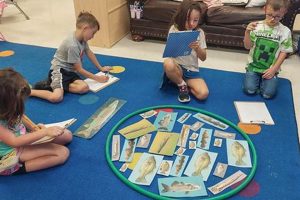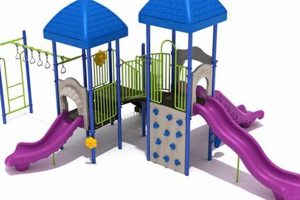Organizing elementary school activities and curriculum around central concepts provides structure and coherence. For example, a science-based concept could encompass experiments, reading materials, and creative projects all related to the chosen scientific principle. This approach offers a cohesive learning experience, linking different subjects and activities under a unifying idea.
A structured learning environment fosters deeper understanding and engagement. It allows educators to create immersive experiences that cater to diverse learning styles and encourage active participation. Historically, thematic instruction has evolved from generalized topics to more specific and interdisciplinary approaches, reflecting a growing understanding of child development and pedagogical effectiveness. This evolution underscores the recognized value of connecting learning to real-world contexts and fostering critical thinking skills.
This article will explore various practical examples, discuss the selection process, and offer guidance on implementing successful thematic units in elementary school classrooms.
Tips for Implementing Thematic Units
Effective thematic units require careful planning and execution. The following tips offer guidance for developing engaging and enriching learning experiences.
Tip 1: Align with Curriculum Standards: Ensure chosen concepts directly correlate with established learning objectives and standards. This guarantees relevance and measurable progress.
Tip 2: Incorporate Variety: Utilize diverse learning resources, including books, experiments, technology, and art projects, to cater to different learning styles and maintain student interest.
Tip 3: Encourage Active Learning: Design activities that promote hands-on engagement and critical thinking. Field trips, debates, and collaborative projects foster deeper understanding.
Tip 4: Assess Regularly: Implement ongoing assessments throughout the thematic unit to monitor student comprehension and adjust instruction as needed. Observation, quizzes, and projects can provide valuable insights.
Tip 5: Integrate Cross-Curricular Connections: Connect the central concept to various subjects, demonstrating the interconnectedness of knowledge. For example, a history theme can incorporate elements of geography, literature, and art.
Tip 6: Consider Student Input: Involving students in the selection process, when appropriate, can increase their motivation and investment in the learning experience.
Tip 7: Create a Stimulating Environment: Transform the classroom into a space that reflects the chosen theme through decorations, displays, and resource materials. This enhances immersion and engagement.
By following these guidelines, educators can create dynamic learning environments that foster deep understanding and a lifelong love of learning.
These practical tips provide a framework for successfully implementing thematic units, enriching the educational experience for all students. The following section will offer concluding thoughts and resources for further exploration.
1. Engaging Content
Engaging content serves as the cornerstone of successful thematic units in elementary education. Thematic instruction relies on capturing student interest to foster deep learning. Content that stimulates curiosity, encourages active participation, and connects to students’ lives significantly impacts the effectiveness of thematic exploration. Without compelling content, even the most well-structured thematic unit risks falling flat, failing to ignite the desired learning outcomes. A unit on “Ancient Civilizations,” for example, becomes truly engaging when students examine artifacts, decipher hieroglyphics, or construct miniature pyramids, rather than passively reading textbook passages.
The selection of engaging content necessitates careful consideration of the target audience. Elementary-aged students respond well to vibrant visuals, interactive activities, and stories that resonate with their developmental stage. Incorporating multimedia elements, hands-on experiments, and opportunities for creative expression amplifies engagement. For instance, a theme focused on “The Solar System” can be significantly enhanced through virtual reality tours of planets, building model rockets, or creating artwork depicting celestial bodies. Such experiences transform abstract concepts into tangible, memorable learning opportunities.
Ultimately, engaging content drives meaningful learning experiences within thematic units. By prioritizing content that captivates and resonates with elementary students, educators create fertile ground for exploration, discovery, and a genuine appreciation for the chosen theme. Challenges may arise in finding appropriate resources or balancing engagement with rigorous academic standards; however, the positive impact of captivating content on student learning justifies the effort invested in its careful selection and implementation. This focus on engagement ensures that thematic units transcend superficial exploration, fostering instead a deep and lasting understanding of the subject matter.
2. Curriculum Alignment
Curriculum alignment serves as a critical foundation for effective thematic instruction in elementary schools. Connecting thematic units to established curriculum standards ensures that learning activities remain focused and purposeful. This alignment provides a framework for measuring student progress against defined learning objectives. Without a clear connection to curriculum standards, thematic units risk becoming isolated activities, potentially failing to contribute meaningfully to overall academic growth. For example, a thematic unit on “Ocean Life” should align with science standards related to ecosystems, life cycles, and adaptation, ensuring that students gain specific knowledge and skills while exploring the chosen theme.
The practical significance of curriculum alignment lies in its ability to provide structure and direction for both educators and students. Teachers can use curriculum standards as a roadmap for designing learning experiences, selecting appropriate resources, and developing assessment strategies. This structured approach ensures that thematic units address essential concepts and skills. Students benefit from understanding the learning goals and recognizing how their activities contribute to their overall academic progress. A thematic unit on “The American Revolution,” for example, can be aligned with history standards related to causes and effects, key figures, and significant events, providing a clear framework for learning and assessment.
Successfully aligning thematic units with curriculum standards requires careful planning and thoughtful selection of activities. Educators must analyze existing standards and identify opportunities to integrate thematic content in a meaningful way. This process often involves adapting existing lesson plans or developing new activities that specifically target relevant standards. While challenges may arise in finding appropriate resources or balancing creativity with standardized learning objectives, the benefits of ensuring curriculum alignmentfocused learning, measurable progress, and meaningful connectionsjustify the effort invested in this crucial planning stage. This alignment ultimately strengthens the educational value of thematic instruction, ensuring that it contributes significantly to student academic growth and development.
3. Differentiated Instruction
Differentiated instruction plays a crucial role in maximizing the effectiveness of thematic units in elementary classrooms. Recognizing that students learn at different paces and through various modalities necessitates an approach that caters to individual needs and learning styles. Thematic units provide a flexible framework within which differentiated instruction can thrive, offering diverse avenues for exploration and expression. Without differentiated instruction, thematic units risk leaving some learners behind, failing to capitalize on individual strengths and address specific learning challenges.
- Varied Learning Activities
Offering a range of activities within a thematic unit allows students to engage with content in ways that resonate with their learning preferences. For a “Space Exploration” theme, some students might thrive building a model spacecraft (kinesthetic), while others might prefer researching different planets (analytical) or creating a dramatic presentation about a mission to Mars (creative). This variety ensures that all learners have opportunities to access and process information effectively.
- Flexible Grouping Strategies
Implementing flexible grouping allows educators to tailor instruction to specific skill levels and learning needs. Within a thematic unit on “Ecosystems,” students might be grouped by interest for research projects, by reading level for exploring related literature, or by skill level for specific science experiments. This dynamic approach ensures that students receive appropriate support and challenge within a collaborative learning environment.
- Tiered Assignments
Tiered assignments provide varying levels of complexity within a shared task, allowing all learners to achieve success and demonstrate growth. In a thematic unit on “Ancient Greece,” a tiered assignment might involve researching and presenting information about Greek mythology. Students working at a basic level might focus on identifying major gods and goddesses, while students at a more advanced level might explore complex mythological narratives and their cultural significance.
- Individualized Learning Goals
Setting individualized learning goals within a thematic unit acknowledges individual student needs and promotes personalized learning pathways. For a theme centered on “Weather,” one student might focus on mastering basic weather terminology, while another might delve into the science behind weather patterns and prediction. This individualized approach ensures that each student experiences meaningful progress and growth within the context of the shared thematic exploration.
By weaving these facets of differentiated instruction into the fabric of thematic units, educators create inclusive and enriching learning environments. This approach ensures that all students, regardless of their learning styles or paces, can actively participate, achieve meaningful learning outcomes, and develop a deeper understanding of the chosen theme. Ultimately, differentiated instruction enhances the power of thematic units, transforming them into dynamic tools for fostering individual student growth and cultivating a lifelong love of learning.
4. Cross-Curricular Connections
Cross-curricular connections represent a vital element within thematic instruction for elementary students. Integrating multiple subjects through a central theme fosters a deeper understanding of the interconnectedness of knowledge. This approach moves beyond isolated subject areas, demonstrating how different disciplines intersect and inform one another. Thematic units provide a natural platform for these connections, allowing students to explore a single concept through various lenses. For instance, a unit on “The Rainforest” can incorporate science (plant and animal life), social studies (indigenous cultures), language arts (reading and writing rainforest-themed stories), and mathematics (calculating rainfall or charting animal populations). This interdisciplinary approach enhances engagement and promotes a more holistic understanding of the topic.
The practical significance of cross-curricular connections lies in their ability to reinforce learning and facilitate knowledge transfer. When students encounter concepts in multiple contexts, they develop a richer and more durable understanding. This approach also strengthens critical thinking skills as students learn to synthesize information from diverse sources and apply their knowledge in varied settings. Furthermore, cross-curricular connections can cater to diverse learning styles and interests, making learning more accessible and engaging for all students. A unit on “Ancient Egypt,” for example, could involve building pyramids (mathematics and engineering), researching Egyptian mythology (language arts and history), and creating hieroglyphic writing (art and language arts), offering multiple entry points for student engagement.
Successful implementation of cross-curricular connections requires careful planning and collaboration among educators. Clear learning objectives should drive the integration of different subjects, ensuring that connections are purposeful and contribute to a deeper understanding of the central theme. While challenges may arise in coordinating across disciplines or finding appropriate resources, the benefits of fostering these connectionsenhanced engagement, deeper understanding, and stronger critical thinking skillsmake this a crucial element of effective thematic instruction. This integrated approach cultivates a more holistic and meaningful learning experience, preparing students for a complex and interconnected world.
5. Real-World Relevance
Real-world relevance forms a crucial bridge between abstract concepts and practical application within thematic instruction for elementary students. Connecting classroom learning to tangible experiences enhances engagement, deepens understanding, and fosters a sense of purpose. Thematic units offer a natural framework for incorporating real-world connections, making learning more meaningful and preparing students for future challenges.
- Community Connections
Integrating community resources and experiences enriches thematic units by providing authentic learning opportunities. A unit on “Local Government” could involve visiting the town hall, interviewing community leaders, or participating in local service projects. These experiences transform abstract concepts into tangible realities, fostering civic engagement and a deeper understanding of local governance.
- Career Exploration
Connecting thematic units to potential career paths demonstrates the practical applications of classroom learning. A unit on “The Human Body” could explore careers in medicine, healthcare, or sports science. Guest speakers, virtual field trips, or research projects can expose students to various career options, fostering awareness and inspiring future aspirations.
- Current Events Integration
Linking thematic units to current events provides relevant context and demonstrates the dynamic nature of knowledge. A unit on “Environmental Conservation” could explore current environmental challenges and solutions. Analyzing news articles, conducting debates, or participating in awareness campaigns can foster critical thinking and empower students to become informed and engaged citizens.
- Problem-Based Learning
Presenting real-world problems as the focus of thematic units encourages critical thinking and problem-solving skills. A unit on “Sustainable Living” could challenge students to design a sustainable community or develop solutions for reducing waste. This approach promotes active learning, collaboration, and a deeper understanding of complex issues.
By incorporating these elements of real-world relevance, thematic units transcend theoretical exploration and become powerful tools for preparing students for future success. Connecting classroom learning to tangible experiences fosters a deeper understanding of the subject matter, cultivates critical thinking skills, and inspires students to become engaged and informed citizens. This emphasis on real-world application strengthens the educational value of thematic instruction, ensuring that it equips students with the knowledge and skills necessary to navigate a complex and ever-changing world.
6. Assessment Strategies
Assessment strategies represent a critical component of thematic instruction in elementary schools. Effective assessment provides valuable insights into student learning, informing instructional decisions and ensuring that thematic units achieve their intended learning outcomes. A comprehensive approach to assessment considers diverse learning styles and utilizes a variety of methods to gauge student understanding and progress. Without robust assessment strategies, thematic units risk becoming engaging activities without a clear mechanism for measuring their impact on student learning.
- Observation
Observational assessment provides ongoing insights into student engagement, collaboration, and understanding. During a thematic unit on “Plant Life Cycles,” teachers can observe students’ participation in hands-on experiments, their interactions during group projects, and their responses to open-ended questions. These observations offer valuable qualitative data that complements formal assessments and informs instructional adjustments.
- Portfolio Assessment
Portfolios showcase student work collected over time, demonstrating growth and achievement within a thematic unit. A portfolio for a “The Solar System” theme might include student-created models of planets, written reports on space exploration, and artwork depicting celestial bodies. This collection provides a tangible record of student learning and allows for individualized assessment of progress.
- Performance-Based Tasks
Performance-based tasks require students to apply their knowledge and skills in authentic contexts. In a thematic unit on “Community Helpers,” students might role-play different community roles, create presentations about local services, or design solutions for community challenges. These tasks assess higher-order thinking skills and demonstrate practical application of learned concepts.
- Self and Peer Assessment
Integrating self and peer assessment fosters metacognitive skills and encourages students to take ownership of their learning. During a thematic unit on “Ancient Civilizations,” students might use rubrics to assess their own research projects or provide constructive feedback on classmates’ presentations. This process promotes reflection, critical thinking, and a deeper understanding of learning expectations.
By incorporating these diverse assessment strategies, educators gain a comprehensive understanding of student learning within thematic units. These assessments not only measure knowledge acquisition but also evaluate critical thinking, problem-solving, and creative expression. This holistic approach ensures that thematic instruction remains purposeful, engaging, and effective in promoting meaningful learning experiences for all elementary students. The data gathered from these assessments informs instructional adjustments, ensuring that thematic units continuously evolve to meet the diverse needs of learners and maximize their educational impact.
Frequently Asked Questions
This section addresses common inquiries regarding thematic instruction in elementary settings.
Question 1: How do thematic units differ from traditional subject-based teaching?
Thematic units organize learning around central concepts, integrating multiple subjects, while traditional teaching typically focuses on individual subjects in isolation.
Question 2: How can one ensure thematic units align with curriculum standards?
Careful planning and selection of activities directly correlated with established learning objectives and standards ensures alignment. Consulting curriculum documents and seeking guidance from curriculum specialists can provide further clarity.
Question 3: What are effective strategies for differentiating instruction within thematic units?
Offering varied learning activities, employing flexible grouping strategies, providing tiered assignments, and setting individualized learning goals address diverse learning needs.
Question 4: How can thematic instruction incorporate real-world relevance?
Connecting thematic units to community resources, exploring career paths, integrating current events, and implementing problem-based learning establishes real-world connections.
Question 5: What assessment methods are most suitable for thematic units?
A combination of observation, portfolio assessment, performance-based tasks, and self/peer assessment provides a comprehensive understanding of student learning.
Question 6: How can parents support thematic learning at home?
Parents can support thematic learning by engaging in discussions related to the theme, exploring related resources together (books, museums, websites), and encouraging children to apply learned concepts in everyday situations.
By addressing these frequently asked questions, a clearer understanding of thematic instruction and its benefits emerges.
For further exploration, the following resources provide additional information and practical guidance.
Themes for Elementary Schools
Organizing elementary curricula around central themes offers a powerful approach to fostering deeper understanding and engagement. This exploration has highlighted the importance of curriculum alignment, differentiated instruction, cross-curricular connections, real-world relevance, and comprehensive assessment strategies in maximizing the effectiveness of thematic units. Engaging content, tailored to developmental stages and diverse learning styles, forms the cornerstone of successful thematic instruction.
Thematic learning represents a dynamic and evolving approach to education, continuously adapting to meet the changing needs of learners. Its potential to ignite curiosity, foster critical thinking, and prepare students for a complex world underscores its significance in shaping future generations. A thoughtful and well-implemented thematic curriculum empowers educators to create enriching learning experiences that cultivate a lifelong love of learning.







